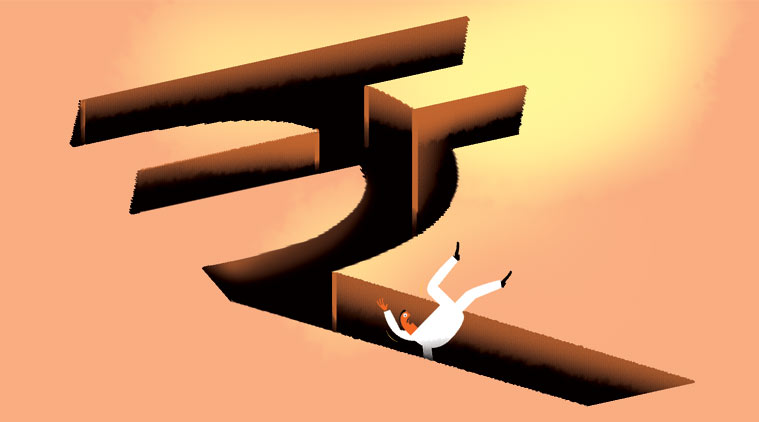Rupee in a global world
India’s macroeconomic framework is based on an antiquated belief that the economy is closed.

The crux of the problem is that India’s macroeconomic framework is based on an antiquated belief that the economy is closed when in reality it is far more open.
I understand that the optics of an 8.2 per cent GDP growth rate followed by a 6 per cent depreciation of the rupee against the dollar is not pretty, but from an economist’s point of view, I do not understand the brouhaha surrounding it.
After languishing for two years, economic growth has begun a recovery of sorts in the last two quarters on the back of a straggling pickup in investment. However, with the government deficit (Centre and states combined) running at over 7 per cent of GDP and likely to widen, the rise in investment is largely being financed abroad. This has raised India’s current account deficit (the part of investment that isn’t funded by domestic savings) from 1.9 per cent of GDP in 2017-18 towards 3 per cent this year. When fiscal and current account deficits widen, the economy adjusts through higher interest rates and exchange rate depreciation. That is exactly what has happened to bond yields and the rupee. With tighter global financial conditions since April and a reassessment of emerging market risk since August, it should not even be surprising that the rise in bond yields and the rupee depreciation has had to be large. With no support from fiscal policy and only modest monetary tightening, all the adjustment has been borne by the exchange rate. When only one variable has to do all the heavy lifting, the adjustment is usually outsized. And that’s what had driven the slide in the rupee. None of this is out of the ordinary. It is exactly what any Economics 101 textbook would say.
Therefore, the ongoing soul searching among analysts and policymakers whether the government and the RBI should or should not stop the slide in the rupee is largely misplaced. It is not about whether one should or should not react to the rupee, but about whether one should or should not react to changes in economic fundamentals that are driving the rupee. In my view, we are asking this question for the umpteenth time in the last 10 years because India’s macroeconomic policy framework has long been overrun by economic reality.
There is an entrenched and widespread belief among the same analysts and policymakers that India is a closed economy protected by its much vaunted regulatory and capital controls. Nothing can be further from the truth. Every time the world sneezes, India catches a cold. It happened in 2008 when Lehman collapsed; in 2011 during the European sovereign debt crisis; in 2013 when hit by the Taper Tantrum; and it is happening now. Consider what happened in the Lehman crisis. On Friday, September 12, 2008, the call money rate in India closed at 6.15 per cent and banks borrowed about Rs 45 billion from the RBI that day. Over that weekend, Lehman collapsed. By the next Wednesday, the call rate had jumped to over 13 per cent and bank borrowing from the RBI had risen to nearly Rs 600 billion! In neighbouring Indonesia, with a significantly more open capital account, the inter-bank rate barely inched in the first week of the crisis.
The crux of the problem is that India’s macroeconomic framework is based on an antiquated belief that the economy is closed when in reality it is far more open. For example, the RBI has rarely linked its policy decisions to changes in global interest rates even after shifting to an inflation-targeting framework. It is the same with fiscal policy. Every budget document begins with a perfunctory paragraph on “global developments” but neither taxes nor expenditure has been changed in response to what has happened outside of India except when forced by crises. The overall fiscal deficit has remained virtually unchanged around 7 per cent of GDP since 2013-14, the year of the Taper Tantrum, despite the global economy, financial conditions, and oil prices undergoing large cyclical changes.
Let me make this more concrete by using monetary policy as an example. The policy statements and the minutes of the Monetary Policy Committee (MPC) meetings suggest that the policy interest rate has been set based on the committee’s view on the 6-12 month ahead inflation and its drivers including inflationary expectations, the slack in the economy, government policies etc. This is the right framework only if the economy is closed. In an open economy, apart from the drivers of inflation, interest rate separately and explicitly responds to changes in global financial conditions too. Many inflation-targeting central banks with open economies, in both developed and emerging markets, routinely publish not only their assessment of how global financial conditions might evolve but also the extent to which their policy actions are determined by the changes in these conditions. That does not mean that these central banks insentiently react to every twist and turn in global financial conditions. They react just as they do to inflation dynamics: Assess the drivers of the changes, determine whether they are transient or permanent, and decide if a response is needed.
While the binary description of being either open or closed does not work for India, it is palpably obvious that in the last 10-15 years, the country has de facto become more open despite extant de jure capital controls. However, India’s fiscal and monetary policy frameworks have not been adapted to the higher and rising degree of external
openness.
openness.
Consequently, when faced with a global financial shock, neither fiscal nor monetary policy has, as matter of course, adjusted to safeguard the economy. Instead, we have scurried around for ad-hoc solutions, as is gaining currency now with suggestions for more NRI deposits or external bond issuance. I am sure we will come up with another clever scheme and then pat ourselves on the back on how that staved off a crisis. However, we will face the same challenge again the next time global conditions change.
The solution is to recognise that India has become more open, that capital controls do not provide adequate protection, and therefore both fiscal and monetary policies need to be adapted to the increased openness. It is not a question of whether one should respond to the rupee slide; it is a question of whether India can continue not to respond to changes in global conditions.
The writer is chief emerging markets economist, J P Morgan. Views are personal.
For all the latest Opinion News, download Indian Express App
More From Jahangir Aziz
Tighter is better
China’s watershed moment
Uncertain new year
Loose fiscal and monetary policies pushed India to brink of crisis in 2013. Wiser policy could avert it in 2018...
The 19th Party Congress has re-identified the ‘principal contradiction’ facing society. There will be consequences ..
US election changed global financial calculations. Emerging markets must wait and watch...






































No hay comentarios:
Publicar un comentario